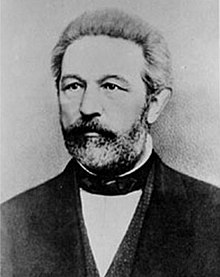Ephraim Willard Burr
Ephraim Willard Burr | |
|---|---|
 | |
| 9th Mayor of San Francisco | |
| In office 1856–1859 | |
| Preceded by | George J. Whelan |
| Succeeded by | Henry F. Teschemacher |
| Personal details | |
| Born | March 7, 1809 Warren, Rhode Island |
| Died | July 20, 1894 (aged 85) San Francisco, California |
| Political party | People's Party |
Ephraim Willard Burr (1809–1894) was a businessman who served as the ninth mayor of San Francisco, California from 1856 to 1859.
Burr was born on March 7, 1809, in Warren, Rhode Island. As a young man, he worked for a whaling company which sent him west. After losing his crew while docked in San Francisco—many sailors were lured away by the prospect of finding gold during the Gold Rush—Burr stayed put and opened a grocery store. His family moved to California to be with him. The venture proved so successful that he opened California's first savings union, the San Francisco Accumulating Fund Association.
Politics[]
He entered politics in 1855 when he petitioned the San Francisco Common Council to curb open-stream pollution caused by local slaughterhouses. Burr stated that the pollution caused cholera to enter the streams, causing three deaths—including that of his son.
Mayor of San Francisco[]
Burr was soon noticed by the Vigilante movement, who recommended him as the People's Party candidate for mayor. He was elected mayor on November 4, 1856, and took office on November 15 of that year. Burr entered office under a new city charter that significantly weakened his powers; however, this did not stop him from cutting city spending (including spending from the formerly separate county government). Nor did this loss of authority stop Burr from reforming the office of city treasurer. (He changed the salary from a percentage of the city receipts to a fixed wage to stop graft.)
He also proposed a plan to make the city Board of Supervisors overlords of the city debt, and to make the city attorney the overseer of the city's legal matters, which were previously handled by outside attorneys.
Retirement[]
After leaving office, Burr devoted himself to business interests. His primary one was the Savings and Loan Society, which he became president of 1857, while he was mayor. He was also president of the San Francisco Fire Insurance Company from 1861 to 1866.
Legacy[]
He loaned $30,000 to build the now-famous cable car system before retiring in 1879. He also built the Burr House which is a San Francisco Landmark and listed on the National Register of Historic Places.
Final Appearance[]
He would make his final public appearance in 1891 when the Board of Supervisors sought to extend Van Ness Avenue to the San Francisco Bay. He wanted to stop the expansion since the extended route went through his property.
Death[]
He died in San Francisco on July 20, 1894. His estate was valued at six million dollars.[1]
References[]
Sources[]
- Heintz, William F., San Francisco's Mayors: 1850-1880. From the Gold Rush to the Silver Bonanza. Woodside, CA: Gilbert Roberts Publications, 1975. (Library of Congress Card No. 75-17094)
Other information[]
What appears to be a well researched thesis paper by a Humboldt State University student provides much more detail into Ephraim Burr's life. http://dscholar.humboldt.edu:8080/dspace/bitstream/2148/398/1/Ilza%20Hakenen%20Thesis.pdf[permanent dead link]
- 1809 births
- 1894 deaths
- People from Warren, Rhode Island
- Mayors of San Francisco
- 19th-century American politicians
- Burials at Cypress Lawn Memorial Park
